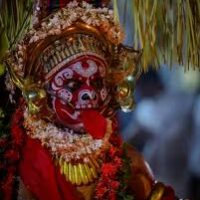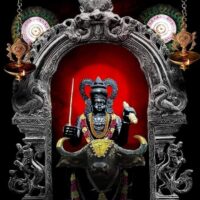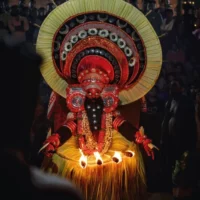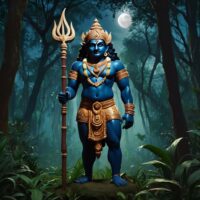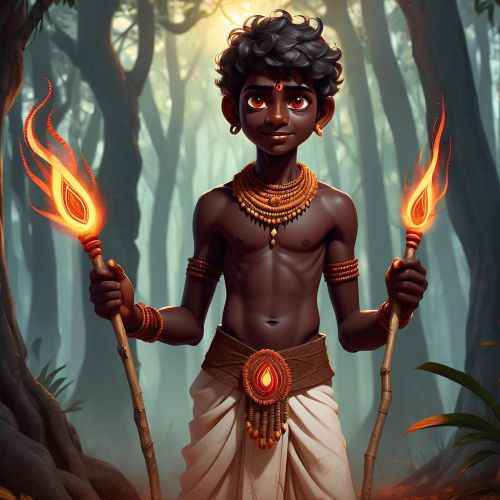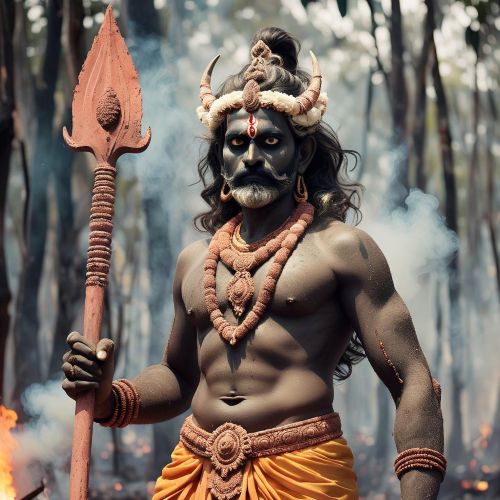Parakutty Chathan : The Wrathful Protector
Listen
At a glance
| Description | |
|---|---|
| Origin | Indian Mythology |
| Classification | Spirits |
| Family Members | Shiva (Father), Koolivaga (Mother), Kuttichathan, Vishnumaya, Karinkutty (Brothers) |
| Region | India |
| Associated With | Protection, Magic |
Parakutty Chathan
Introduction
Parakutty Chathan is a powerful guardian deity worshipped within the Vishnumaya Chathan pantheon of Kerala. Unlike the more widely recognized gods from the Indian epics, Parakutty is a distinctly local presence rooted in Dravidian, tribal, and folk traditions. He is not a distant mythological figure but a living deity invoked by devotees for protection, prosperity, and spiritual balance. Considered both a protector and a punisher, Parakutty Chathan represents the duality often seen in Kerala’s ritual deities, where benevolence is showered upon the faithful, while wrath is directed toward those who engage in deceit or wrongdoing.
Parakutty Chathan is especially revered in parts of central and northern Kerala, where his temples, shrines, and kavus (sacred groves) still serve as spaces for family worship and community gatherings. His presence in rituals, festivals, and Theyyam performances underscores his importance as a guardian deity whose powers extend over households, land, and livestock.
Physical Traits
Unlike major pan-Indian gods who have fixed canonical images, Parakutty Chathan’s appearance is shaped largely by oral traditions and ritual art. He is often visualized in Theyyam performances and temple murals as a warrior-like figure, armed with weapons or ritual implements that signify his protective powers. His attire reflects Kerala’s traditional style, sometimes marked by ornaments, sacred beads, and symbolic colors associated with strength and spiritual energy.
One recurring motif in his depictions is his association with animals, especially the buffalo, a symbol of raw power and agrarian significance. His fierce makeup and body art in Theyyam serve to highlight his formidable nature, reminding worshippers of his role as both guardian and enforcer. In many shrines, Parakutty Chathan is imagined seated alongside Vishnumaya Kuttichathan and his divine mother, reinforcing his place within a larger spiritual lineage. These representations, though varied, emphasize his warrior spirit and his function as a deity deeply tied to village life.
Family
The mythology of Parakutty Chathan is woven into the larger narrative of Vishnumaya and the Chathan deities of Kerala. In regional lore, his mother is Koovivaga, a forest goddess believed to have connections with Shiva. Some traditions explicitly link Parakutty’s lineage to Lord Shiva, while others emphasize his independent identity as a guardian spirit born of divine and earthly unions.
He is closely associated with Karinkutty Chathan, another protective deity often worshipped alongside him. Together with Vishnumaya Kuttichathan, they form a powerful triad that safeguards villages, families, and agricultural life. Narratives about Chathan Swami, considered to be born of Sree Parvathy, also connect Parakutty Chathan to this broader divine genealogy. In temple worship, these deities are invoked collectively, reflecting the belief that their combined presence offers comprehensive protection against misfortune, illness, and spiritual harm.
Other names
Parakutty Chathan is known by several names and titles that highlight his role and attributes. The name “Parakutty” itself is sometimes spelled “Parukutty,” a regional variation seen in temple records and oral chants. He is also addressed as Kaval Deivam, meaning guardian deity, reflecting his role as the protector of households, fields, and cattle. In many communities, he is worshipped as a Kulaparadevata, or clan deity, particularly in Nair families and among tribal groups who continue to uphold ancestral traditions.
Another association ties him to Kutty Chathan or “little Sastha,” linking him indirectly to the broader pantheon of Sastha deities. In older Pulaya traditions, Parukutty was among the demon-gods revered alongside Kali and Chathan, underscoring his importance in folk religious practices that blended ancestral worship with divine reverence. These alternative names and associations highlight the adaptability of his worship across different social groups and local traditions.
Powers and Abilities
The powers attributed to Parakutty Chathan are primarily protective and spiritual, though they carry a strong element of retribution. As a guardian of villages and families, he is believed to watch over farmlands, fisheries, and livestock, ensuring prosperity and safety. His worship often involves offerings of liquor, roosters, and tobacco, reflecting his fierce and earthy nature, unlike the more sanitized rituals of classical Hindu gods.
He is invoked to counteract evil forces, black magic, and deceit. Folklore describes him as a spirit born with the divine purpose of destroying asuras, similar to other warrior deities tied to Shiva. In one tale, when Chathan was wounded in battle, drops of his blood gave rise to 400 “Kuttichathans,” spirits that extended his power and influence. His disciple Karimkutty is also said to have joined him in repelling attacks, reinforcing the theme of Parakutty as both leader and protector.
Certain rituals performed during the new moon (Amavasi) nights are believed to draw out his strongest powers. During these ceremonies, devotees seek relief from mental burdens, curses, or family misfortunes. His role as a spiritual intercessor makes him both a divine guardian and a channel through which people can confront their fears and adversities.
Modern Day Influence
In present-day Kerala, Parakutty Chathan continues to be a significant figure in both ritual and cultural life. Temples such as the Vadakkumpuram Vishnumaya Devasthanam actively conduct rituals in his honor, keeping his worship alive among devotees. His presence is particularly strong in rural households and family shrines, where he is invoked for protection during agricultural cycles and family milestones.
Culturally, Parakutty Chathan has a prominent role in Theyyam performances, especially in northern Kerala. Through these dramatic ritual dances, his myths are retold, and his powers are re-enacted, allowing communities to maintain a living connection with their ancestral guardian. These performances also serve as public expressions of justice, where the deity, through the medium of the performer, addresses the concerns of devotees directly.
In modern times, worshippers also see him as a source of psychological relief. Many believe that rituals dedicated to him help alleviate anxiety, depression, and spiritual unease, functioning as a form of communal healing. His lore has found its way into digital spaces as well, with websites, social media platforms, and diaspora communities sharing his stories and images. This digital revival ensures that younger generations, even those living outside Kerala, remain connected to their cultural roots.
Parakutty Chathan’s enduring influence illustrates how localized deities continue to thrive alongside mainstream Hindu traditions. His role as a fierce protector, a punisher of evil, and a divine guardian ensures that his presence remains vital in both ritual worship and everyday spirituality.
Related Images
Source
Vadakkumpuram Sree Vishnumaya Devasthanam. (2023). Parakutty Chathan. Retrieved from https://vadakkumpuram.in/parakutty-chathan/
Wikipedia contributors. (2023). Kuttichathan. Wikipedia. Retrieved from https://en.wikipedia.org/wiki/Kuttichathan
Ramana Maharshi Foundation. (2024). Chathan: The Folk Deity Worshipped in Kerala. Retrieved from https://www.ramana-maharshi.org/chathan-the-folk-deity-worshipped-in-kerala/
[PDF] On Chattan. Conflicting Statements about a South Indian Deity. (2020). https://shs.hal.science/halshs-02937007/file/Chattan_conflicting_statements.pdf
Frequently Asked Questions
What is lorem Ipsum?
I am text block. Click edit button to change this text. Lorem ipsum dolor sit amet, consectetur adipiscing elit. Ut elit tellus, luctus nec ullamcorper mattis, pulvinar dapibus leo.
What is lorem Ipsum?
I am text block. Click edit button to change this text. Lorem ipsum dolor sit amet, consectetur adipiscing elit. Ut elit tellus, luctus nec ullamcorper mattis, pulvinar dapibus leo.
What is lorem Ipsum?
I am text block. Click edit button to change this text. Lorem ipsum dolor sit amet, consectetur adipiscing elit. Ut elit tellus, luctus nec ullamcorper mattis, pulvinar dapibus leo.
What is lorem Ipsum?
I am text block. Click edit button to change this text. Lorem ipsum dolor sit amet, consectetur adipiscing elit. Ut elit tellus, luctus nec ullamcorper mattis, pulvinar dapibus leo.
What is lorem Ipsum?
I am text block. Click edit button to change this text. Lorem ipsum dolor sit amet, consectetur adipiscing elit. Ut elit tellus, luctus nec ullamcorper mattis, pulvinar dapibus leo.


